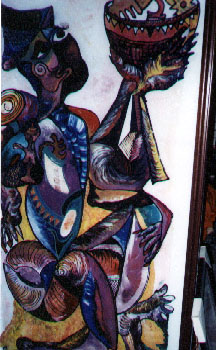Aziz - Owner of Aziz Gallery and Poet.
Thomas Moss, co-owner of Holland, Taylor and Moss Distinctive Gentlemen's Wear
Earl Underwood,co-owner of The Leimert Park Gallery and founder of Leimert Park Business Center
Vanessa Taylor, owner of Flower Nuts
-in progress:
Beverly Cashen - Executive Director of Leimert Park Village Community Development Corporation
Richard Fulton, owner of Fifth Street Dick's Coffee House

1. Tell me about yourself?
2. What was the deciding factors
to go into this business or service?
3. What's the history and purpose
of your business or service?
4. What attracted you to this location?
5. How do you feel your business
impacts the community? How does the community impact your business?
6. How would you describe the community?
7. What changes have you witnessed
in the community recently? Last few years?
8. What changes do you envision
in the next few?
9. How do you see these changes
impacting your business?
This list of questions was given to the interviewees several days prior to the interview. This was done for several reasons. The first was that I sought some points of consistency and reference in the varying interviews. I also did not want to surprise or offend any of the merchants who decided to donate their time and ideas. Concerns of being misrepresented was initially expressed by merchants, both by some that agreed and did not to. Also, many merchants were warmly receptive to sharing their opinions on Leimert Park and the surrounding community. This eagerness to share the positive occurrences and energy was countered by disappointment that once the information is extracted from the community, the interviewer would not be heard again. The length of the interviews ranged from twenty-five minutes to an hour. The interviews were held on sight at the location of business during regular business hours. This introduced diverse and interesting aspects into the interview. Multiple times there was interruption, phones, fax machines, street traffic sounds, electronic pagers, customers, children, and other merchants were the main causes of breaks. Although this was at times this was mildly annoying, these instances highlight the special nature of Leimert Park's integrated sense of community as one that is constantly in motion.Beverly Cashen, for example, was in the midst of searching for assistance, so there where phone calls and faxes through out the interview with hopeful applicants. Vanessa Taylor was selling clothing merchandise, flowers and speaking to neighborhood children as we spoke. There were also times when the interviewee and myself were not necessarily as coherent as possible. Thomas Moss, for example, was recovering from a cold. Earl Underwood and I, met early Saturday morning. Neither of us was awake as of yet. As we spoke, Underwood was constantly sipping his first cup of coffee and greeting children and parents for the weekly Saturday morning art class. Aziz's electronic pager was constantly buzzing and there were several browsers with questions that interrupted us. Before I interviewed Richard Fulton in the afternoon, around 2 p.m., I participated in the daily ritual of setting up and arranging the numerous tables, chairs and booths inside the coffee house and on the adjoining sidewalk outside. Throughout the near hour long interview, Fulton was acknowledged by people passing by, and curious locals also offered their input at times. Then there was the naïve and unfortunate luck I experienced as an inexperienced interviewer. In two interviewers the record button was not pushed hard enough, so with patience on behalf of the interviewee the interview was restarted. There was also the lack of forethought of where to place the tape recorder in relation to the changing environments that included background noises of music, street traffic and conversations of others. Frustration also arose in attempting to have the tapes professionally transcribed, after I realized the amount of time needed to do so was probably too overwhelming and ambitious for what I had originally planned. The agency contracted to transcribe the tapes did not return them in a timely manner, expressed concern about the context of the tapes, and did not transcribe one interview after all had been said and done. One example of this is that in Aziz's interview he refers to his style of painting is something that occurs in the "moment." After reviewing the transcript, "moment" was mistaken for the word "money," which clearly had no connection to the thread of conversation. Typos such as this required me to back track into the interviewing tapes, at which points I then often found several sentences left out or key words.
Despite these minor setbacks, this was a very positive experience. I hope you enjoy learning more about this unique and dynamic community as I have.